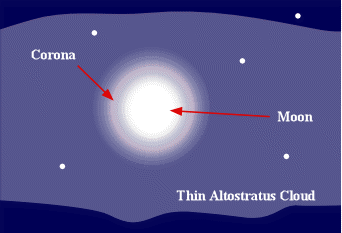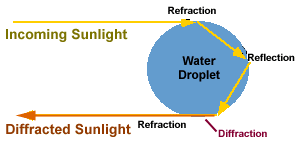|
|
. |
Coronas
produced by diffraction of light
When the distance between the drops is similar to the wavelength of
visible light, the light that shines through the cloud droplets is
diffracted and dispersed in the manner
shown below. On a clear night, for example, the light you see coming
from the moon is coning straight from the moon. However if a thin cloud
layer is found between the observer and the moon, the diffraction and
dispersion of the moonlight actually casts a light larger than the
original light source. This 'crown' of light around the sun or moon is
called the corona.

When the cloud droplets are very uniform in size, the diffracted light
can cause the corona to be separated into its component colors, with
blue light to the inside of the red light.
These colors may repeat themselves, surrounding the moon with a series
of colored rings, becoming fainter as each subsequent ring is located
further from the moon.
Also, a combination of refraction, reflection and diffraction can
combine to produce other optical effects such as glories and the
"Heiligenschein" effect -- which is a bright area around the head
of an observer's shadow on a surface containing spherical water
droplets. Glories are the rings of illuminated light seen most
commonly from plane's shadows as they fly over clouds of liquid
water. In both phenomena, the light ultimately is bent close to
180° right back to the observer.

As a beam of light encounters a water droplet, it is refracted as
it enters the droplet. Portions of the light are then internally
reflected off the backside of the droplet. Before the light exits
the droplet completely, it diffracts along the droplet's outer
surface for just an instant as a surface wave before refracting as
it leaves the droplet.

ice crystals
|
|

linings, iridescence
|
|



